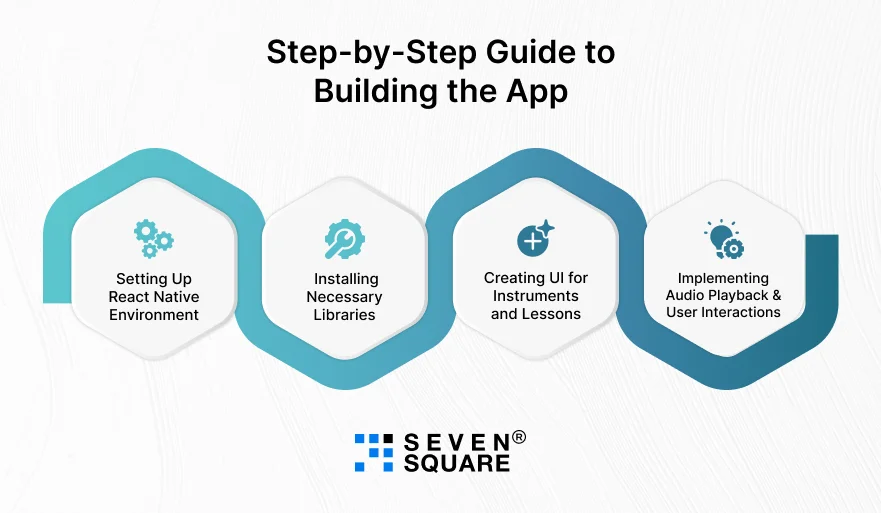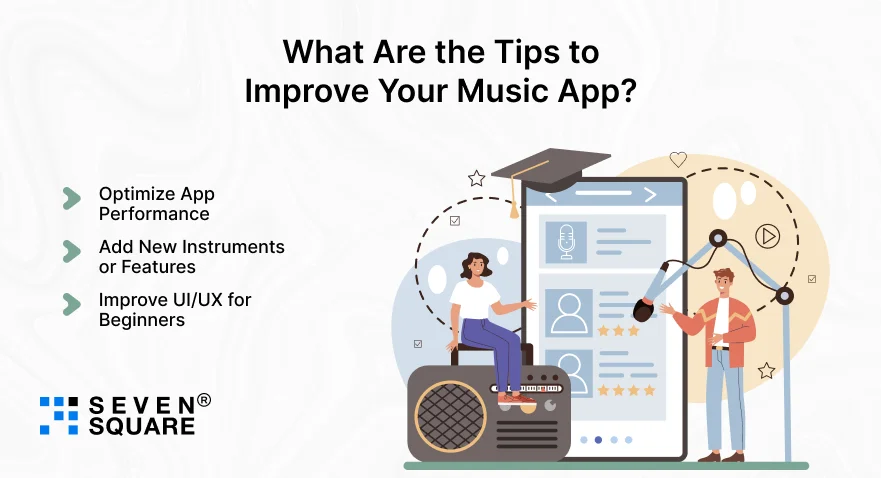With more usage of smartphones and tablets, interactive music instrument learning apps have become the go-to solution for learners worldwide.
Whether you’re a budding musician, a developer, or a startup entrepreneur, building a React Native music app tutorial can open doors to a huge market.
Interactive music apps are in high demand because they combine learning with engagement.
Users can practice instruments, follow lessons, and get real-time feedback, all from their mobile devices.
By creating a React Native music instrument app, you can allow users to learn anywhere, anytime, while leveraging the cross-platform power of React Native.
Investing in a music learning app is a smart move. It also opens revenue opportunities through subscriptions, in-app purchases, and premium features.
Building an interactive music app in React Native is both innovative and profitable. If you want a React Native music player tutorial, then you are at the right place.
What You Should Know About React Native & Music App Development?
You need to understand why React Native is perfect for building music learning apps.
React Native allows developers to create cross-platform apps using a single codebase.
This means you can launch your app on both Android and iOS without duplicating effort, saving time and cost, key concerns for startups and businesses.
When it comes to music apps, audio playback is the heart of the experience.
A React Native audio playback tutorial teaches how to handle sounds efficiently, whether it’s piano notes, guitar chords, or drum beats.
Libraries like React Native Track Player and Expo AV make implementing real-time audio smooth.
With these fundamentals, you can develop a robust React Native music instrument app that delivers smooth, interactive sound experiences for learners.
What Are the Core Features Your Music Instrument Learning App Must Have?
To stand out in the market, your music learning app must be feature-rich and intuitive. Here’s what every successful React Native music app UI design should include:
- Interactive Lessons & Tutorials: Step-by-step lessons for multiple instruments. Users can learn at their own pace.
- Real-Time Audio Playback & Practice Mode: Learners can play along with the app and receive instant feedback.
- Gamified Elements: Points, badges, and levels keep users motivated and engaged.
- Multi-Instrument Support: Allow users to practice piano, guitar, drums, and more within a single app.
By focusing on these core features, you can build a music learning app React Native that appeals to both beginners and advanced learners, ensuring a high engagement rate and user retention.
Step-by-Step Guide to Building the App (With Code)

Building an interactive music instrument learning app in React Native can be complex, but with this step-by-step guide to building a music app with React Native, you can create a fully functional app in no time.
Learn everything from setting up your environment to implementing audio playback and UI design.
Step 1: Setting Up React Native Environment
To start, ensure you have Node.js and npm installed. Then install the React Native CLI:
# Install React Native CLI globally
npm install -g react-native-cli
# Create a new React Native project
npx react-native init MusicLearningApp
# Navigate to the project folder
cd MusicLearningApp
This sets up a React Native music app project ready for development.
Step 2: Installing Necessary Libraries
For audio playback and interactive lessons, install these libraries:
# Expo AV for audio playback
npm install expo-av
# React Native Track Player for background audio and controls
npm install react-native-track-player
# React Navigation for app navigation
npm install @react-navigation/native @react-navigation/stack
# Required dependencies for React Navigation
npm install react-native-screens react-native-safe-area-context
These libraries ensure your React Native music app with GitHub source code can handle real-time audio playback, multi-screen navigation, & a smooth user experience.
Step 3: Creating UI for Instruments and Lessons
Designing a user-friendly interface is important. Here’s a simple example for a piano lesson screen:
// components/PianoLesson.js
import React from 'react';
import { View, Text, TouchableOpacity, StyleSheet } from 'react-native';
const keys = ['C', 'D', 'E', 'F', 'G', 'A', 'B'];
export default function PianoLesson({ playNote }) {
return (
<View style={styles.container}>
<Text style={styles.title}>Piano Lesson</Text>
<View style={styles.keysContainer}>
{keys.map((key) => (
<TouchableOpacity
key={key}
style={styles.key}
onPress={() => playNote(key)}
>
<Text style={styles.keyText}>{key}</Text>
</TouchableOpacity>
))}
</View>
</View>
);
}
const styles = StyleSheet.create({
container: { flex: 1, justifyContent: 'center', alignItems: 'center' },
title: { fontSize: 24, fontWeight: 'bold', marginBottom: 20 },
keysContainer: { flexDirection: 'row' },
key: { backgroundColor: '#fff', padding: 20, margin: 5, borderRadius: 5 },
keyText: { fontSize: 18, fontWeight: 'bold' },
});
This is the foundation for your interactive music app React Native UI.
Step 4: Implementing Audio Playback & User Interactions
Using Expo AV, you can play audio notes when a key is pressed:
// App.js
import React from 'react';
import { SafeAreaView } from 'react-native';
import { Audio } from 'expo-av';
import PianoLesson from './components/PianoLesson';
export default function App() {
const playNote = async (note) => {
const soundObject = new Audio.Sound();
try {
await soundObject.loadAsync(require(`./assets/notes/${note}.mp3`));
await soundObject.playAsync();
// Unload the sound after playback
soundObject.setOnPlaybackStatusUpdate((status) => {
if (status.didJustFinish) soundObject.unloadAsync();
});
} catch (error) {
console.log('Error playing note:', error);
}
};
return (
<SafeAreaView style={{ flex: 1 }}>
<PianoLesson playNote={playNote} />
</SafeAreaView>
);
}
Notes:
- Save your audio files in assets/notes/ (e.g., C.mp3,D.mp3, etc.).
- This setup allows real-time interaction, making your app engaging and educational.
Here’s the Complete GitHub Code to Build an Interactive Music Instrument Learning App in React Native.
How to Make the App Interactive & Engaging?
Engagement is the key to retention in any learning app. To make your app truly interactive, consider these strategies:
- Gamification: Add points, levels, and progress tracking to motivate learners. Gamified elements make users come back daily.
- Real-Time Feedback: Offer instant feedback on timing, accuracy, and rhythm for each instrument. This ensures users feel guided and supported.
- Animations & Visual Cues: Use colorful animations and visual indicators to highlight notes, beats, and chords. This creates an immersive experience.
When you focus on engagement, your interactive music app React Native will educate & also entertain.
By combining these elements, you effectively build an interactive music learning app using React Native that keeps users coming back for more.
Why Choose Us for Your React Native App Development?
If you want to build an app in React Native, then our experienced team of developers can help you turn your idea into a reality.
- Experience in creating interactive music apps in React Native with real-time playback, gamified lessons, and dynamic UI.
- From idea validation to deployment, we handle everything for your app development.
- Our experts in React Native music app UI design create layouts that make learning fun, engaging, and dynamic.
- We help you build a music learning app React Native that grows with your user base.
Want a Customized React Native App? Contact Us Now!
What Are the Tips to Improve Your Music App?

Once your app is functional, optimizing and refining it is important. Here’s how to take your React Native music player tutorial to the next level:
- Optimize App Performance: Ensure smooth playback and minimal lag, even with multiple audio tracks.
- Improve UI/UX for Beginners: Simple, intuitive navigation and clear visual cues make learning fun.
- Add New Instruments or Features: Continuously update your app based on user feedback to stay competitive and relevant.
By implementing these strategies, you can ensure your build music learning app React Native remains modern, interactive, and appealing to users of all skill levels.
Learn, Play, and Build
Building a React Native music app tutorial can be an exciting opportunity for anyone who is looking to enter the educational app market.
With interactive lessons, real-time audio playback, gamification, and intuitive UI, your app can change how users learn music.
Allow users to learn, play, and grow musically while leveraging the power of React Native for a smooth & cross-platform experience.
FAQs
- React Native is perfect for music instrument learning apps because it’s fast, cross-platform, & easy to integrate with sound libraries like Expo AV and React Native Track Player.
- It also provides great UI/UX performance for interactive music features.
- A great React Native music instrument app should include:
- Interactive lessons
- Real-time feedback
- Gamification (points, badges, levels)
- Multi-instrument support
- Offline mode and cloud sync
- These make your app more engaging and educational.
- You can make your app more interactive by adding animations, sound effects, gamified challenges, and real-time progress tracking.
- These techniques make users feel more engaged and improve the overall learning experience.